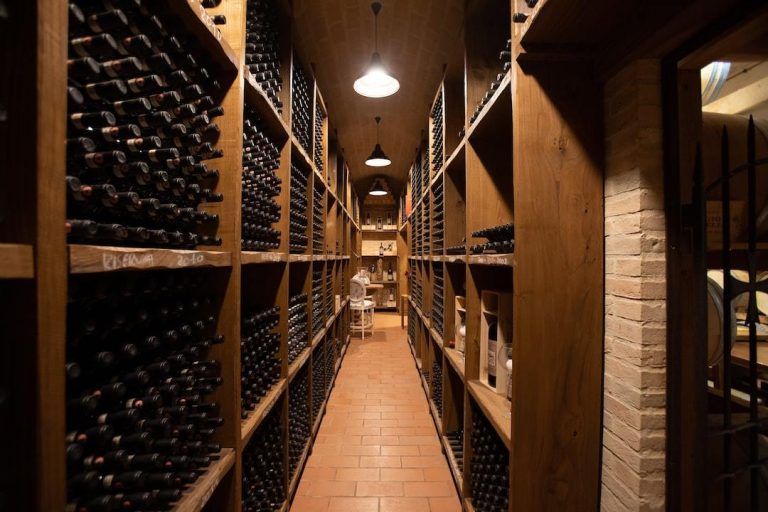
Maintaining the correct temperature is critical in preserving the integrity of the wine, a fact you’ll appreciate more as you understand the dynamics of temperature-controlled wine transportation and how it can potentially save your savory investment.
But how exactly does this work, and why is it so important? Well, let’s find out.
Understanding Wine Storage Basics
First, we’ll share the ideal storage temperatures for red and white wines. Then, we will discuss the risks of improper wine transportation and how temperature-controlled liquid logistics benefit you. We will also explain the underlying technology and how you can choose reliable wine-moving services in your area. DIY wine moving or trusting rookie transportation companies can ruin your collection. Avoid it!
The Wine Mover knows how to protect your wine collection with our state-of-the-art reefer trucks. Contact us today to learn how we can help you move that precious wine across any distance.
Ideal Storage Temperatures for Red and White Wine
The ideal wine storage temperature varies for each kind. For red wine, the storage temperature should be between 50-65 degrees Fahrenheit. This range allows red wines’ complex flavors and structures to develop over time.
On the other hand, white wine storage temperature tends to be lower, usually between 40-50 degrees Fahrenheit. This keeps the crisp, refreshing characteristics of your white wines intact. You can find the complete list here.
Wine Storage Options

Several options are available for storing your wine, each with unique benefits and drawbacks.
Traditional wine cellars and modern wine coolers are popular choices. Wine cellars offer a perfect wine storage temperature but can be costly and space-consuming. On the other hand, wine coolers are relatively affordable, portable, and allow precise temperature control.
Wine racks or cabinets are also practical, especially for short-term storage. However, these options mightn’t provide the optimal wine storage temperature.
Understanding your needs, budget, and space availability is essential before deciding. Remember, improper storage can ruin your wine, so choose wisely.
Risks of Improper or DIY Wine Transportation
You might think transporting wine yourself is easy and cost-effective, but the risks are too many.
Exposure to prolonged heat or extreme cold can seriously degrade the taste of your wine.
Taste Degradation Due to Prolonged Heat Exposure
Prolonged heat exposure can degrade your wine’s delicate balance of flavors, causing it to lose its unique character and become ‘cooked.’
White wines are often more heat-sensitive. If not stored correctly, your white wines can lose their crisp, fresh flavors and become flat and uninteresting.
Heat exposure during wine transportation could also cause wine leakage, disturbing the cork position and ultimately leading to alteration of wine quality. Other effects include reduction of sulfur dioxide and color development (especially browning of white wines).
Possible damage from Cold Temperatures
While excessive heat can ruin your wine’s flavor, it’s equally important to note that cold temperatures carry their own set of risks, especially during DIY wine transportation.
Cold can cause the wine to freeze, leading to the expansion of the liquid, which in turn can push the cork out and allow air in. This not only spoils the wine but also risks damaging your storage area.
Frequent temperature fluctuations can further compound this issue, causing your wine to age prematurely.
Container Rain
Improper or DIY methods can lead to a problematic phenomenon known as ‘Container Rain.’ This occurs when temperature control isn’t correctly managed, causing condensation inside the container.
Imagine you’ve invested in a valuable collection of wines, only to open the containers and find them damaged by moisture.
Benefits of Temperature-Controlled Transport
Quality Preservation
To ensure your wine retains its quality, consider the significant benefits of temperature-controlled transportation. This method offers crucial quality preservation by maintaining the wine’s comfort zone.
Like many other delicate products, wine has specific storage and transportation requirements. Temperature variations can compromise these requirements, leading to undesirable changes in your wine’s taste and aroma.
Temperature-controlled transport eliminates these risks. It ensures your wine stays within its optimal temperature range throughout the journey.
Prolonged Shelf Life
With temperature-controlled transport, your wine’s shelf life can significantly increase, giving you more time to enjoy its exquisite character. Wine moving services that offer temperature-controlled transport ensure your wine stays in optimal condition, extending its longevity.
Therefore, investing in temperature-controlled wine moving services is more than a luxury. It’s very much needed if you want your wine to stay good for as long as possible.
Technology Behind Temperature-Controlled Transportation
You might wonder how temperature-controlled transportation works. It’s all about the tech!
Reefer Trucks equipped with modern thermostats

When it comes to temperature-controlled transportation, reefer trucks equipped with modern thermostats play a crucial role. These trucks are high-tech mobile refrigerators.
The modern thermostat, its brain, ensures the temperature stays as you’d want, no matter the weather outside.
Remote Monitoring
Moving companies get real-time alerts if the temperature variations exceed the set range, thanks to GPS trackers and Bluetooth sensors, allowing them to intervene promptly and prevent potential damage to your precious cargo. So, whether you’re shipping across town or the country, you can relax knowing your wine is safe.
Advanced Cooling Technologies
Advanced cooling systems are energy-efficient and use dual temperature zones to adjust the internal temperature of the transport containers, allowing the transportation of different wines at their ideal temperatures within the same truck. These technologies are environment-friendly and provide the correct airflow management and humidity control.
Insulation Materials
Insulation materials work hand in hand with the cooling systems, creating a stable environment for your wine. They’re responsible for preventing heat transfer and maintaining the desired temperature.
The specialized containers have substantial 3-4 inches of urethane insulation covering all sides, ensuring good thermal properties. They feature T-grate floors, ensuring water drains out via water outlets without harming the insulation.
Protection from Light
Shielding your wine from light is another crucial aspect of temperature-controlled transportation. High-tech transport vehicles often use tinted glass or specially designed storage compartments that block out harmful light while keeping the interior cool. Some even incorporate LED lighting, which emits minimal UV rays.
Choosing Your Wine Transportation Service
When picking your wine transportation service, there are several key factors you’ll want to consider. Think about their experience with long-haul wine deliveries, their reputation in the industry, and whether they offer adequate insurance coverage. Once you have decided, use this wine shipment guide.
Experience in handling long-haul wine deliveries

Given the delicate nature of wine, choosing a wine transportation service experienced in long-haul deliveries is vital. You want your wine to arrive pristine, just as it left the vineyard. An experienced company understands the paperwork, shows up with adequate human resources, and has a proper maintenance routine for all its equipment.
Not all services are equal, so don’t rush your decision. Ask potential providers about their experience. Inquire about previous deliveries, their inventory and packaging services, temperature control methods, and how they handle unexpected situations.
Reputation
A company’s reputation speaks volumes about its reliability and commitment to customer satisfaction. Be bold in asking for references or proof of successful deliveries.
Look for companies with positive online reviews and testimonials from satisfied clients. After all, your wine’s journey from vineyard to glass should be as smooth as possible.
Insurance Coverage

Insurance coverage acts as your safety net, compensating for any unexpected losses. Be bold about asking the company about their insurance policy. They should be able to explain the specifics, including what’s covered and what’s not. Also, check if they cover the total value of your wine or just a fraction. Getting a wine appraisalfrom an independent expert will also help you if anything goes wrong.
Cost Vs. Risk Analysis
While ensuring your wine is fully insured is critical, it’s equally important to analyze the potential risks and costs of choosing a wine transportation service.
You might be tempted to opt for the cheapest service or DIY shipping, but remember, you often get what you pay for. Low-cost services might not have the safeguards to maintain optimal temperatures or handle your wine carefully, leading to potential damage.
Moving Forword
So, you’ve got the lowdown on wine storage. You know the risks of DIY transport and the benefits of temperature-controlled shipping. You’re even clued up on the tech behind it.
Remember, investing in proper transport can be a day-saver when maintaining your wine’s quality. Don’t leave it to chance. Make a choice that ensures your wine arrives in perfect condition.
The Wine Mover provides transportation services to private collectors, the wine industry, and other relocation companies. It doesn’t matter if you have 20 or 20,000 bottles; trust us to ship your wine carefully.







